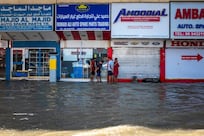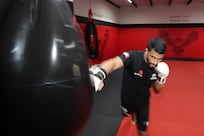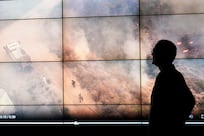ABU DHABI // Negotiating the streets with a child in a pram can be stressful and dangerous, parents are complaining.
A lack of ramps and crossings, narrow sections of pavement separating the road from parking areas, and blocked and obstructed footpaths impede easy and safe access.
Tracy Bensabai, 42, from the UK, lives in Al Mushrif between the churches and the International School of Choueifat with her husband and two young children.
She said kerbs did not have pram-friendly ramps and many pavements had no concrete surface, meaning she must drag her child's pram through sand or step out on to busy roads.
"Imagine a mother with a pushchair," Ms Bensabai said. "One can't get on the pavement, so where do you go? Cross the road where it's not safe or go up across the grass and sand?"
Parents who cannot get their pram on the pavement end up pushing the child on the road and navigating between cars, she said. "It's an issue that affects a lot of people."
Jessica Hill, 34, also from the UK, agreed that the high kerbs made walking with a pram difficult.
On one corner, she said, a neighbour had erected a barrier and refused to take it down, meaning pedestrians had to step off the pavement and on to the road to pass.
"We live in one of the oldest parts of Abu Dhabi, which has been neglected over the years," Ms Hill said. "The city has well-marked roads but some are not well thought out."
Every Friday, while church and mosque services are held, cars are parked haphazardly along streets and pavements, further obstructing pram-pushers.
Ibrahim Al Hmoudi, transport planning department manager at the Urban Planning Council, said this would change soon.
Abu Dhabi's new urban streets design code puts pedestrians first, accommodating the needs of women and children, people with disabilities and those on bicycles.
The upgraded Urban Street Design Manual sets out guidance for pavements, buildings, streets and other facilities in the capital.
"Pedestrian sidewalks should be free of obstacles, while the design of the kerb ramps should facilitate crossing for wheelchair users, people pushing strollers, and cyclists," Mr Al Hmoudi said.
"Buildings and streets should likewise be free of obstacles and elevation changes between the street and the sidewalk."
The design manual was introduced in 2010 to provide a safer, more comfortable and aesthetically pleasing street environment.
"We should have a city free of accidents and this necessitates good planning," Mr Al Hmoudi said at a road safety forum on Tuesday.
All new streets will follow the manual standards and, in time, older streets will be renovated.
"Streets that serve lower density residential neighbourhoods will be designed for low traffic speed with safe pedestrian crossings," Mr Al Hmoudi said.
"This is to encourage walking to local services and to provide quiet environments for the families who live within them."
When the manual was implemented during the upgrade of Salam Street, narrower lanes were built to reduce traffic speed and pedestrian-crossing distances were shortened.
Adequate dimensions for all pedestrian refuge islands, particularly those in the median, were also taken into account. Two metres is the minimum needed to protect people pushing a stroller or cyclists from the traffic, Mr Al Hmoudi said.
Ms Bensabai welcomed any efforts to enhance road safety in Al Mushrif and praised new raised pedestrian crossings near the churches and schools.
But for the sake of her stroller, she hopes to soon see more sections of the pavement covered.






